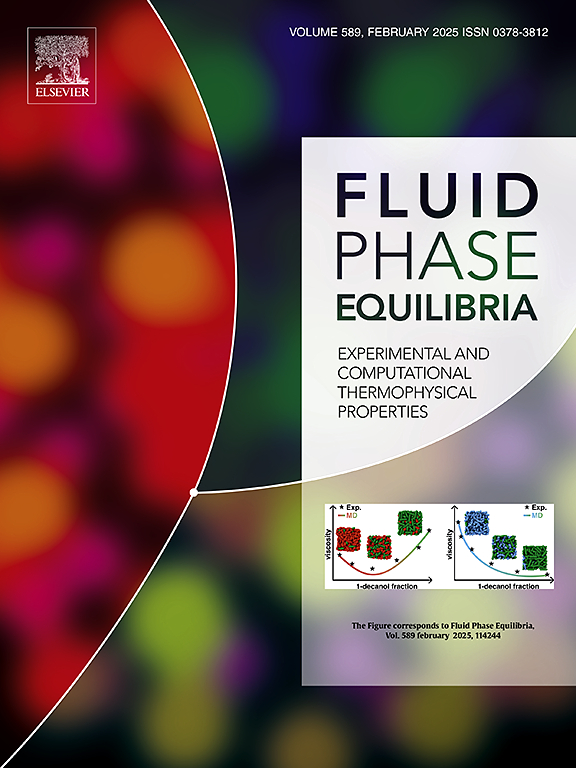Vapor–liquid equilibrium measurements of the carbon dioxide + water (CO2+H2O) system and carbon dioxide + water + sodium chloride (CO2+H2O+NaCl) system
IF 2.8
3区 工程技术
Q3 CHEMISTRY, PHYSICAL
引用次数: 0
Abstract
Accurate phase equilibrium data for CO2 mixtures are essential for safe and cost-effective design of carbon capture, transport and storage chains. We report measurements of the saturation water content of the carbon dioxide-rich phase for both the CO2+H2O and the CO2+H2O+NaCl system. The experiments span the temperatures 35–120 °C, pressures 1–70 MPa, and NaCl concentrations of 0, 78 and 150 g NaCl/kg water (NaCl molalities 0, 1.3 and 2.6). Total uncertainties in the reported water mole fractions are mostly between 100 and 300 ppm. The measurements are compared to previous literature data, and two equations of state: the Spycher model and EOS-CG. The EOS-CG model agrees well with our CO2+H2O data at high pressures, but generally overpredicts the water content at pressures below 15 MPa. The Spycher model agrees well with our data for CO2+H2O at pressures below 15 MPa, but exhibits some systematic deviations that can be traced to simplifying assumptions made in the model development. The Spycher model predicts the influence of NaCl on water content fairly well, but surprisingly we find that better results are obtained simply by applying Raoult’s law for the influence of ions on water activity. We derive theoretically-based bounds on the influence of salt on water content, and use them to investigate systematic errors in the measurements presented herein and in the literature. The present work indicates a clear potential to improve both models and that some previous water content measurements of the CO2-rich phase may have substantial systematic errors.
二氧化碳+水(CO2+H2O)体系和二氧化碳+水+氯化钠(CO2+H2O+NaCl)体系的气液平衡测量
二氧化碳混合物的准确相平衡数据对于碳捕获、运输和储存链的安全和具有成本效益的设计至关重要。本文报道了CO2+H2O和CO2+H2O+NaCl体系富二氧化碳相饱和水含量的测量结果。实验温度为35 ~ 120℃,压力为1 ~ 70 MPa, NaCl浓度分别为0、78和150 g NaCl/kg水(NaCl摩尔浓度分别为0、1.3和2.6)。报告的水摩尔分数的总不确定度大多在100到300 ppm之间。测量结果与先前的文献数据进行了比较,并比较了两个状态方程:Spycher模型和EOS-CG。EOS-CG模型与我们在高压下的CO2+H2O数据吻合良好,但通常高估了压力低于~ 15 MPa的水含量。Spycher模型与我们在压力低于~ 15 MPa的CO2+H2O的数据非常吻合,但显示出一些系统偏差,这些偏差可以追溯到模型开发过程中所做的简化假设。Spycher模型很好地预测了NaCl对水含量的影响,但令人惊讶的是,我们发现简单地应用Raoult定律来计算离子对水活度的影响可以得到更好的结果。我们推导了基于理论的盐对水含量影响的界限,并使用它们来研究本文和文献中提出的测量中的系统误差。目前的工作表明,这两个模型都有明显的改进潜力,而且以前对富二氧化碳阶段的一些水含量测量可能存在重大的系统误差。
本文章由计算机程序翻译,如有差异,请以英文原文为准。
求助全文
约1分钟内获得全文
求助全文
来源期刊

Fluid Phase Equilibria
工程技术-工程:化工
CiteScore
5.30
自引率
15.40%
发文量
223
审稿时长
53 days
期刊介绍:
Fluid Phase Equilibria publishes high-quality papers dealing with experimental, theoretical, and applied research related to equilibrium and transport properties of fluids, solids, and interfaces. Subjects of interest include physical/phase and chemical equilibria; equilibrium and nonequilibrium thermophysical properties; fundamental thermodynamic relations; and stability. The systems central to the journal include pure substances and mixtures of organic and inorganic materials, including polymers, biochemicals, and surfactants with sufficient characterization of composition and purity for the results to be reproduced. Alloys are of interest only when thermodynamic studies are included, purely material studies will not be considered. In all cases, authors are expected to provide physical or chemical interpretations of the results.
Experimental research can include measurements under all conditions of temperature, pressure, and composition, including critical and supercritical. Measurements are to be associated with systems and conditions of fundamental or applied interest, and may not be only a collection of routine data, such as physical property or solubility measurements at limited pressures and temperatures close to ambient, or surfactant studies focussed strictly on micellisation or micelle structure. Papers reporting common data must be accompanied by new physical insights and/or contemporary or new theory or techniques.
 求助内容:
求助内容: 应助结果提醒方式:
应助结果提醒方式:


